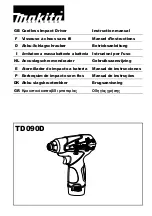
ENGLISH
33
• These chargers are not intended for
any uses other than charging D
E
WALT
rechargeable batteries.
Any other uses
may result in risk of fire, electric shock or
electrocution.
• Do not expose charger to rain or snow.
• Pull by plug rather than cord when
disconnecting charger.
This will reduce risk
of damage to electric plug and cord.
• Make sure that cord is located so that it
will not be stepped on, tripped over, or
otherwise subjected to damage or stress
.
• Do not use an extension cord unless it
is absolutely necessary.
Use of improper
extension cord could result in risk of fire,
electric shock, or electrocution.
• Do not place any object on top of charger
or place the charger on a soft surface that
might block the ventilation slots and result
in excessive internal heat.
Place the charger
in a position away from any heat source. The
charger is ventilated through slots in the top and
the bottom of the housing.
• Do not operate charger with damaged cord
or plug
— have them replaced immediately.
•
Do not operate charger if it has received
a sharp blow, been dropped, or otherwise
damaged in any way.
Take it to an authorised
service centre.
• Do not disassemble charger; take it to an
authorised service centre when service or
repair is required.
Incorrect reassembly may
result in a risk of electric shock, electrocution or
fire.
• In case of damaged power supply cord the
supply cord must be replaced immediately by
the manufacturer, its service agent or similar
qualified person to prevent any hazard.
• Disconnect the charger from the outlet
before attempting any cleaning. This will
reduce the risk of electric shock.
Removing
the battery pack will not reduce this risk.
• NEVER
attempt to connect 2 chargers together.
• The charger is designed to operate on
standard 230V household electrical power.
Do not attempt to use it on any other
voltage.
This does not apply to the vehicular
charger.
SAVE THESE INSTRUCTIONS
Chargers
The DCB100, DCB105, DCB107 and DCB112
chargers accept 10.8 V Li-Ion batteries.
These chargers require no adjustment and are
designed to be as easy as possible to operate.
Charging Procedure (fi g. 2)
1. Plug the charger (k) into an appropriate outlet
before inserting battery pack.
2. Insert the battery pack (f) into the charger.
The red (charging) light will blink continuously
indicating that the charging process has started.
3. The completion of charge will be indicated by
the red light remaining ON continuously. The
pack is fully charged and may be used at this
time or left in the charger.
NOTE:
To ensure maximum performance and life of
Li-Ion batteries, charge the battery pack fully before
first use.
Charging Process
Refer the tables below for the state of charge of the
battery pack.
State of charge–DCB100 and DCB105
charging
– – – –
fully charged
–––––––––––
hot/cold pack delay
–– – –– –
replace battery pack
•••••••••••
State of charge–DCB107 and DCB112
charging
–– –– –– –– ––
fully charged
––––––––––––––––––––
hot/cold pack delay ––
–– –– –––––––
Hot/Cold Pack Delay
DCB100 AND DCB105
When the charger detects a battery that is too hot
or too cold, it automatically starts a Hot/Cold Pack
Delay, suspending charging until the battery has
reached an appropriate temperature. The charger
then automatically switches to the pack charging
mode. This feature ensures maximum battery life.
DCB107 AND DCB112
When the charger detects a battery that is hot, it
automatically delays charging until the battery has
cooled.
When the charger detects a battery that is cold, it
automatically delays charging until the battery has
warmed.
The red light will continue to blink, but a yellow
indicator light will be illuminated during this
operation. Once the battery has cooled, the yellow
light will turn off and the charger will resume the
charging procedure.
Содержание XR Li-Ion DCF813
Страница 1: ...DCF813 DCF815 ...
Страница 3: ...1 Figure 1 Figure 2 b a g e f g h i j DCF813 b a g e f g h c DCF815 d f k ...
Страница 4: ...2 Figure 3 Figure 4 Figure 5 f c d c d e j i ...
Страница 171: ...169 ...
















































